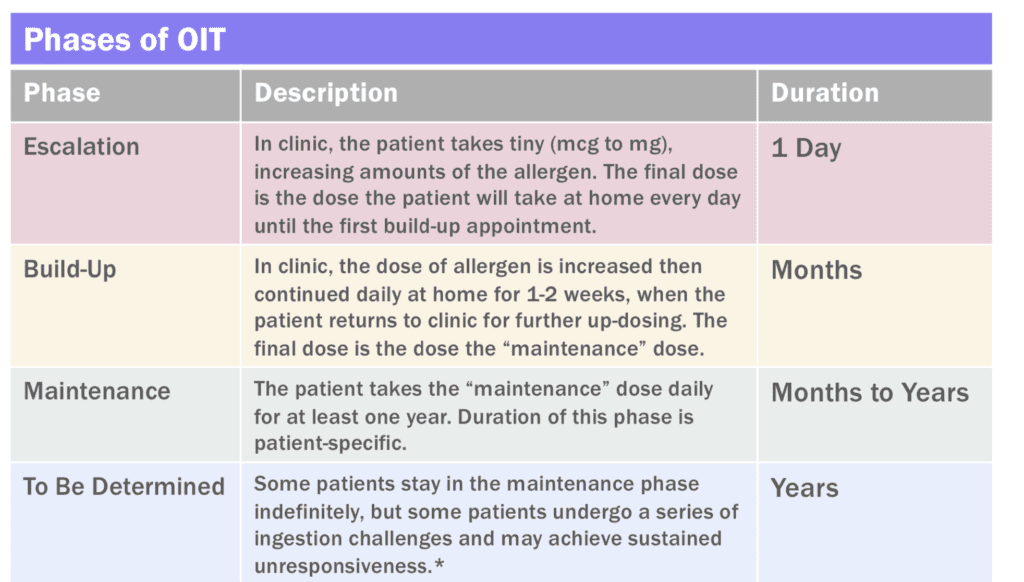Peanut allergy has an FDA-approved OIT treatment
Peanut allergy affects 2-5% of children. The treatment plan for peanut allergy recommended by most academic allergy centers is avoidance of peanut – perhaps until now. Hello, Palforzia, the only FDA-approved treatment for peanut allergy. Palforzia works through the treatment process called oral immunotherapy (OIT). Read on to learn more about peanut oral immunotherapy (OIT) and Palforzia.
What is Oral Immunotherapy (OIT)?
Oral immunotherapy – known as “OIT” – is a way to teach the immune system to tolerate a food. For over a decade, private practices have been utilizing OIT protocols to help patients with food allergies. In addition, academic institutions have helped patients. They play a major role in providing a better understanding OIT, such as how the treatment works and the safety of this treatment. OIT is based on the principles of classic pollen immunotherapy, such as “allergy shots.” Furthermore, allergy shots have been used for over a century to teach the immune system to tolerate environmental allergens, such as pollens.
Allergy versus Immune Tolerance
If you haven’t yet read my infoblog Allergy Versus Immune Tolerance, take a few minutes to read it. It will provide important insight into this topic.
How does OIT work?
OIT works by slowly exposing the immune system to small, increasing amounts of the allergen over a prolonged period of time. This treatment MUST be done under the direct supervision of an allergist because there is a risk of severe allergic reactions. Over time, the immune system essentially gets used to the allergen. In other words, the immune system becomes “tolerant” of the food. The level of tolerance is patient-specific. More on this later.
Palforzia and Other Forms of Allergen in Peanut OIT
OIT protocols typically use one of two types of allergen approaches: pharmaceutical/research-grade allergenic protein, or supermarket products. Palforzia is a pharmaceutical product with quite exact amounts of peanut protein per capsule. Your allergist will tell you how many capsules your kiddo will need for each dose of OIT. Capsules are not to be directly swallowed but should be opened into a refrigerated or room-temp food, mixed, then consumed. Many allergists prefer this approach over using supermarket products. They prefer it because of the well-measured amounts of peanut proteins per capsule. Alternatively, private practices have had success with OIT when using supermarket products, such as peanut flour and and other peanut products. Ask your allergist which approach is right for you, and read the package prescribing information for Palforzia here.
OIT Timeline
Four phases make up the OIT Timeline: Escalation, Build-Up, Maintenance, and Post-Maintence. I call the Post-Maintenance phase the “TBD” phase (see the OIT Table). After Maintenance, some patients may be able to eat their allergen whenever they want and in whatever quantity they want. That being said, “bite proof” is the limit of some patients’ tolerance. “Bite proof” means that the patient can ingest a bite of the food without having a reaction, but more than a bite of the food may cause a reaction (though hopefully a less-severe reaction than if the patient had not undergone OIT).
Phases of OIT
OIT is a multi-year process and should only be performed under the supervision of an allergist.
See the “Phases of OIT” Table below to learn about each phase.

Risks and Time Commitment with OIT
OIT is a good treatment option for many patients with food allergy, but patients and their families need to consider the risks and commitment prior to starting therapy.
Risks of OIT
This treatment can cause allergic reactions including anaphylaxis. OIT requires direct supervision of the child for two hours, during which time the child cannot exercise because exercise lowers the threshold for anaphylaxis. Other risk factors for anaphylaxis include sickness, fever, and NSAIDs. In adolescent and adult patients, patients must avoid alcohol as it too increases the risk of allergic reaction. To minimize the risk of reaction, kiddos undergoing OIT should take their doses at the same time every day. Patients should only take the dosage prescribed by the allergist, never more. Also, some patients have developed eosinophilic esophagitis, which is a food allergy that affects the esophagus.
I can’t say it enough: OIT requires allergist supervision, and it is not the right treatment plan for everyone.
Time Commitment with OIT
Then there is the time commitment. OIT requires the patient take the prescribed dosage of allergen every day. Patients cannot miss doses and must have direct supervision for two hours after each dose. Supervision must be by someone who knows how to recognize and respond to an allergic reaction. This can be challenging for some families who are in a very busy season.
What’s next for Peanut OIT, Palforzia, and other food allergies?
I hope you’ve enjoyed reading about peanut oral immunotherapy (OIT) and Palforzia. Whether you support pharma-OIT products or supermarket-OIT products (or both!), I imagine you are excited about the progress in the world of food allergy treatments – I am! OIT is not right for every patient. In fact, allergen avoidance is a solid treatment plan for many patients. Talk with your allergist about what’s best for your kiddo!
Have your peanut allergy OIT and other food allergy questions answered on the podcast! Submit your question HERE!
Additional Notes
I have talked about a non-profit…
The non-profit is The Teal Schoolhouse, whose primary program is Code Ana. Code Ana equips schools for medical emergencies like anaphylaxis. Our primary program is the Code Ana School Program, which is a comprehensive approach to school-focused medical preparedness. This program guides schools through the process of creating a medical emergency response plan. This is one of the most important components of a school’s food allergy policy!
A medical emergency response plan is important for all kiddos and for adults at any school! Our primary goal is to share the School Program, and Code Ana’s Online Epinephrine Training Program helps support that goal. Through this program, you will educate yourself while you support this important mission! (BTW although Pam and I serve in leadership roles of Code Ana and The Teal Schoolhouse, our time/effort/work is completely voluntary). Does your kiddo’s school have Code Ana?

